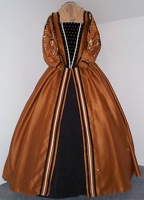Clothes
Clothing refers to any covering for the human body. The wearing of clothing is exclusively a human characteristic and is a feature of most human societies. The amount and type of clothing worn depends on functional considerations (such as a need for warmth or protection from the elements) and social considerations. In some situations the minimum amount of clothing (i.e. covering of a person's genitals) may be socially acceptable, while in others much more clothing is expected.
Functionality is the primary purpose of clothing. It can serve as protection from the elements. Clothes also enhance safety during hazardous activities such as hiking and cooking, by providing a barrier between the skin and the environment. Further, clothes provide a hygienic barrier, keeping toxins away from the body and limiting the transmission of germs.
Clothing performs a range of social and cultural functions, such as individual, occupational and sexual differentiation, and social status. A uniform, for example, may identify civil authority figures, such as police and military personnel, or it may identify team, group or political affiliations.
In many societies, norms about clothing reflect standards of modesty, religion, gender, and social status. Clothing may also function as a form of adornment and an expression of personal taste or style.
Clothing can and has in history been made from a very wide variety of materials. Materials have ranged from leather and furs, to woven materials, to elaborate and exotic natural and synthetic fabrics.
Not all body coverings are regarded as clothing. Articles carried rather than worn (such as purses), worn on a single part of the body and easily removed (scarves), worn purely for adornment (jewelry), or those that serve a function other than protection (eyeglasses), are normally considered accessories rather than clothing, as are footwear and hats.
Function
It can be said that there are four primary factors in clothing comfort, identifiable as the '4 Fs of Comfort' (1) fashion; (2) feel; (3) fit; and (4) function.[2] One of the primary purposes of clothing is to keep the wearer comfortable. In hot climates, clothing provides protection from sunburn or wind damage, while in cold climates its thermal insulation properties are generally more important. Shelter usually reduces the functional need for clothing. For example, coats, hats, gloves, shoes, socks, and other superficial layers are normally removed when entering a warm home, particularly if one is residing or sleeping there. Similarly, clothing has seasonal and regional aspects, so that thinner materials and fewer layers of clothing are generally worn in warmer seasons and regions than in colder ones.
Humans have shown extreme inventiveness in devising clothing solutions to environmental hazards. Some examples include: space suits, air conditioned clothing, armor, diving suits, swimsuits, bee-keeper gear, motorcycle leathers, high-visibility clothing, and other pieces of protective clothing. Meanwhile, the distinction between clothing and protective equipment is not always clear-cut, since clothes designed to be fashionable often have protective value and clothes designed for function often consider fashion in their design.[1]
